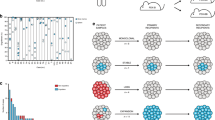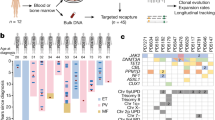Abstract
Little is known of the genetic architecture of cancer at the subclonal and single-cell level or in the cells responsible for cancer clone maintenance and propagation. Here we have examined this issue in childhood acute lymphoblastic leukaemia in which the ETV6–RUNX1 gene fusion is an early or initiating genetic lesion followed by a modest number of recurrent or ‘driver’ copy number alterations. By multiplexing fluorescence in situ hybridization probes for these mutations, up to eight genetic abnormalities can be detected in single cells, a genetic signature of subclones identified and a composite picture of subclonal architecture and putative ancestral trees assembled. Subclones in acute lymphoblastic leukaemia have variegated genetics and complex, nonlinear or branching evolutionary histories. Copy number alterations are independently and reiteratively acquired in subclones of individual patients, and in no preferential order. Clonal architecture is dynamic and is subject to change in the lead-up to a diagnosis and in relapse. Leukaemia propagating cells, assayed by serial transplantation in NOD/SCID IL2Rγnull mice, are also genetically variegated, mirroring subclonal patterns, and vary in competitive regenerative capacity in vivo. These data have implications for cancer genomics and for the targeted therapy of cancer.
This is a preview of subscription content, access via your institution
Access options
Subscribe to this journal
Receive 51 print issues and online access
$199.00 per year
only $3.90 per issue
Buy this article
- Purchase on Springer Link
- Instant access to full article PDF
Prices may be subject to local taxes which are calculated during checkout




Similar content being viewed by others
Accession codes
Primary accessions
Gene Expression Omnibus
Data deposits
SNP array data have been deposited in the Gene Expression Omnibus (http://www.ncbi.nlm.nih.gov/geo/) under accession code GSE24412.
References
Greenman, C. et al. Patterns of somatic mutation in human cancer genomes. Nature 446, 153–158 (2007)
Beroukhim, R. et al. The landscape of somatic copy-number alteration across human cancers. Nature 463, 899–905 (2010)
Fox, E. J., Salk, J. J. & Loeb, L. A. Cancer genome sequencing—an interim analysis. Cancer Res. 69, 4948–4950 (2009)
Marusyk, A. & Polyak, K. Tumor heterogeneity: causes and consequences. Biochim. Biophys. Acta 1805, 105–117 (2010)
Dick, J. E. Stem cell concepts renew cancer research. Blood 112, 4793–4807 (2008)
Klein, C. A. et al. Genetic heterogeneity of single disseminated tumour cells in minimal residual cancer. Lancet 360, 683–689 (2002)
Greaves, M. F. & Wiemels, J. Origins of chromosome translocations in childhood leukaemia. Nature Rev. Cancer 3, 639–649 (2003)
Mullighan, C. G. et al. Genome-wide analysis of genetic alterations in acute lymphoblastic leukaemia. Nature 446, 758–764 (2007)
Bateman, C. M. et al. Acquisition of genome-wide copy number alterations in monozygotic twins with acute lymphoblastic leukemia. Blood 115, 3553–3558 (2010)
Loncarevic, I. F. et al. Trisomy 21 is a recurrent secondary aberration in childhood acute lymphoblastic leukemia with TEL/AML1 fusion. Genes Chromosom. Cancer 24, 272–277 (1999)
Kitagawa, Y. et al. Prevalent involvement of illegitimate V(D)J recombination in chromosome 9p21 deletions in lymphoid leukemia. J. Biol. Chem. 277, 46289–46297 (2002)
Mullighan, C. G. et al. BCR-ABL1 lymphoblastic leukaemia is characterized by the deletion of Ikaros. Nature 453, 110–114 (2008)
Feldhahn, N. et al. Activation-induced cytidine deaminase acts as a mutator in BCR-ABL1-transformed acute lymphoblastic leukemia cells. J. Exp. Med. 204, 1157–1166 (2007)
van Dongen, J. J. M., Szczepanski, T. & Adriaansen, H. J. in Leukemia (eds Henderson, E. S., Lister, T. A. & Greaves, M. F.) 85–129 (Saunders, 2002)
le Viseur, C. et al. In childhood acute lymphoblastic leukemia, blasts at different stages of immunophenotypic maturation have stem cell properties. Cancer Cell 14, 47–58 (2008)
Castor, A. et al. Distinct patterns of hematopoietic stem cell involvement in acute lymphoblastic leukemia. Nature Med. 11, 630–637 (2005)
Hong, D. et al. Initiating and cancer-propagating cells in TEL-AML1-associated childhood leukemia. Science 319, 336–339 (2008)
Breatnach, F., Chessells, J. M. & Greaves, M. F. The aplastic presentation of childhood leukaemia: a feature of common-ALL. Br. J. Haematol. 49, 387–393 (1981)
Horsley, S. W. et al. Genetic lesions in a preleukemic aplasia phase in a child with acute lymphoblastic leukemia. Genes Chromosom. Cancer 47, 333–340 (2008)
Zuna, J. et al. TEL deletion analysis supports a novel view of relapse in childhood acute lymphoblastic leukemia. Clin. Cancer Res. 10, 5355–5360 (2004)
Mullighan, C. G. et al. Genomic analysis of the clonal origins of relapsed acute lymphoblastic leukemia. Science 322, 1377–1380 (2008)
Nowell, P. C. The clonal evolution of tumor cell populations. Science 194, 23–28 (1976)
Gatenby, R. A. & Vincent, T. L. An evolutionary model of carcinogenesis. Cancer Res. 63, 6212–6220 (2003)
Merlo, L. M. F., Pepper, J. W., Reid, B. J. & Maley, C. C. Cancer as an evolutionary and ecological process. Nature Rev. Cancer 6, 924–935 (2006)
Teixeira, M. R. et al. Karyotypic comparisons of multiple tumorous and macroscopically normal surrounding tissue samples from patients with breast cancer. Cancer Res. 56, 855–859 (1996)
Takahashi, T. et al. Clonal and chronological genetic analysis of multifocal cancers of the bladder and upper urinary tract. Cancer Res. 58, 5835–5841 (1998)
Cottu, P. H. et al. Intratumoral heterogeneity of HER2/neu expression and its consequences for the management of advanced breast cancer. Ann. Oncol. 19, 596–597 (2008)
Park, S. Y. et al. Cellular and genetic diversity in the progression of in situ human breast carcinomas to an invasive phenotype. J. Clin. Invest. 120, 636–644 (2010)
Clark, J. et al. Complex patterns of ETS gene alteration arise during cancer development in the human prostate. Oncogene 27, 1993–2003 (2008)
Shipitsin, M. et al. Molecular definition of breast tumor heterogeneity. Cancer Cell 11, 259–273 (2007)
Maley, C. C. et al. Genetic clonal diversity predicts progression to esophageal adenocarcinoma. Nature Genet. 38, 468–473 (2006)
Aubele, M. et al. Intratumoral heterogeneity in breast carcinoma revealed by laser-microdissection and comparative genomic hybridization. Cancer Genet. Cytogenet. 110, 94–102 (1999)
Boland, C. R. et al. Microallelotyping defines the sequence and tempo of allelic losses at tumour suppressor gene loci during colorectal cancer progression. Nature Med. 1, 902–909 (1995)
Geyer, F. C. et al. Molecular analysis reveals a genetic basis for the phenotypic diversity of metaplastic breast carcinomas. J. Pathol. 220, 562–573 (2010)
Navin, N. et al. Inferring tumor progression from genomic heterogeneity. Genome Res. 20, 68–80 (2010)
Stoecklein, N. H. et al. Direct genetic analysis of single disseminated cancer cells for prediction of outcome and therapy selection in esophageal cancer. Cancer Cell 13, 441–453 (2008)
Attard, G. et al. Characterization of ERG, AR and PTEN gene status in circulating tumor cells from patients with castration-resistant prostate cancer. Cancer Res. 69, 2912–2918 (2009)
Klein, C. A. & Stoecklein, N. H. Lessons from an aggressive cancer: evolutionary dynamics in esophageal carcinoma. Cancer Res. 69, 5285–5288 (2009)
Kuukasjärvi, T. et al. Genetic heterogeneity and clonal evolution underlying development of asynchronous metastasis in human breast cancer. Cancer Res. 57, 1597–1604 (1997)
Tsao, J.-L. et al. Colorectal adenoma and cancer divergence. Evidence of multilineage progression. Am. J. Pathol. 154, 1815–1824 (1999)
Campbell, P. J. et al. Subclonal phylogenetic structures in cancer revealed by ultra-deep sequencing. Proc. Natl Acad. Sci. USA 105, 13081–13086 (2008)
Barrett, P. H., et al., eds. Charles Darwin’s Notebooks, 1836–1844 (Cambridge Univ. Press, 1987)
Adams, J. M. & Strasser, A. Is tumor growth sustained by rare cancer stem cells or dominant clones? Cancer Res. 68, 4018–4021 (2008)
Visvader, J. E. & Lindeman, G. J. Cancer stem cells in solid tumours: accumulating evidence and unresolved questions. Nature Rev. Cancer 8, 755–768 (2008)
Rosen, J. M. & Jordan, C. T. The increasing complexity of the cancer stem cell paradigm. Science 324, 1670–1673 (2009)
Greaves, M. Cancer stem cells: back to Darwin? Semin. Cancer Biol. 20, 65–70 (2010)
Maenhaut, C., Dumont, J. E., Roger, P. P. & van Staveren, W. C. G. Cancer stem cells: a reality, a myth, a fuzzy concept or a misnomer? An analysis. Carcinogenesis 31, 149–158 (2010)
Shackleton, M., Quintana, E., Fearon, E. R. & Morrison, S. J. Heterogeneity in cancer: cancer stem cells versus clonal evolution. Cell 138, 822–829 (2009)
Polyak, K. Breast cancer: origins and evolution. J. Clin. Invest. 117, 3155–3163 (2007)
Liu, W. et al. Copy number analysis indicates monoclonal origin of lethal metastatic prostate cancer. Nature Med. 15, 559–565 (2009)
Nannya, Y. et al. A robust algorithm for copy number detection using high-density oligonucleotide single nucleotide polymorphism genotyping arrays. Cancer Res. 65, 6071–6079 (2005)
Kearney, L. & Colman, S. in Methods in Molecular Biology. Leukemia. Methods and Protocols Vol. 538 (ed. So, C. W. E.) 57–70 (Humana Press, 2009)
Maecker, H. T. & Trotter, J. Flow cytometry controls, instrument setup, and the determination of positivity. Cytometry A 69, 1037–1042 (2006)
Acknowledgements
This work is supported by specialist programme grants from The Kay Kendall Leukaemia Fund (M.G.) and Leukaemia & Lymphoma Research (M.G., T.E.) and a Deutsche Forschungsgemeinschaft fellowship LU 1474/1-1 (to C.L.). T.E. and C.L. acknowledge support from the Oxford BRC.
Author information
Authors and Affiliations
Contributions
K.A. carried out the FISH analyses. C.L. and Y.G. conducted the in vivo experiments. C.M.B. analysed the SNP array and FISH analysis of the patient with aplasia and ALL. S.M.C. and I.T. performed cell immunostaining and sorting. F.W.v.D. provided SNP array data. H.K., A.V.M. and J.S. provided patient data and samples. T.E. advised on design and interpretation of in vivo experiments. L.K. supervised the FISH studies. L.K. and M.G. designed the overall study. M.G. wrote the paper with critical input from T.E., L.K. and other authors.
Corresponding author
Ethics declarations
Competing interests
The authors declare no competing financial interests.
Supplementary information
Supplementary Information
This file contains Supplementary Figures 1-10 with legends and Supplementary Tables 1-4. (PDF 4219 kb)
Rights and permissions
About this article
Cite this article
Anderson, K., Lutz, C., van Delft, F. et al. Genetic variegation of clonal architecture and propagating cells in leukaemia. Nature 469, 356–361 (2011). https://doi.org/10.1038/nature09650
Received:
Accepted:
Published:
Issue Date:
DOI: https://doi.org/10.1038/nature09650
This article is cited by
-
Molecular portraits of lung cancer evolution
Nature (2023)
-
Clonal architecture evolution in Myeloproliferative Neoplasms: from a driver mutation to a complex heterogeneous mutational and phenotypic landscape
Leukemia (2023)
-
Evaluating outcomes of adult patients with acute lymphoblastic leukemia and lymphoblastic lymphoma treated on the GMALL 07/2003 protocol
Annals of Hematology (2022)
-
The lysine methyltransferase SMYD2 is required for normal lymphocyte development and survival of hematopoietic leukemias
Genes & Immunity (2020)
-
Single cell analysis of clonal architecture in acute myeloid leukaemia
Leukemia (2019)
Comments
By submitting a comment you agree to abide by our Terms and Community Guidelines. If you find something abusive or that does not comply with our terms or guidelines please flag it as inappropriate.



